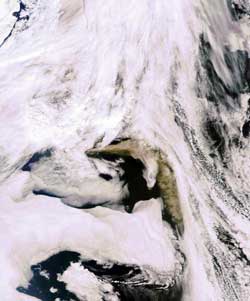Envisat captures renewed volcanic activity

New eruptions from Iceland\'s Eyjafjallajoekull volcano have produced a 1600 km-wide ash cloud over the Atlantic. The brownish plume, traveling east and then south, is clearly visible in stark contrast to white clouds framing this Envisat image from May 6, 2010. Credit: ESA<br>
The volcano began emitting steam and ash on 20 March, wreaking havoc on European aviation last month. Renewed activity earlier this week caused some flights to be suspended to and from Ireland, Northern Ireland and Scotland.
Authorities are monitoring the position and height of the ash cloud as well as the direction of prevailing Atlantic winds, which pose a problem when they blow south towards Ireland, located 1500 km southeast of the volcano.
Envisat's Medium Resolution Imaging Spectrometer (MERIS) acquired this image. To see the latest MERIS images of the ash cloud, visit our MIRAVI website. MIRAVI, which is free and requires no registration, generates images from the raw data collected by MERIS and provides them online quickly after acquisition.
Media Contact
More Information:
http://www.esa.intAll latest news from the category: Earth Sciences
Earth Sciences (also referred to as Geosciences), which deals with basic issues surrounding our planet, plays a vital role in the area of energy and raw materials supply.
Earth Sciences comprises subjects such as geology, geography, geological informatics, paleontology, mineralogy, petrography, crystallography, geophysics, geodesy, glaciology, cartography, photogrammetry, meteorology and seismology, early-warning systems, earthquake research and polar research.
Newest articles

Eruption of mega-magnetic star lights up nearby galaxy
Thanks to ESA satellites, an international team including UNIGE researchers has detected a giant eruption coming from a magnetar, an extremely magnetic neutron star. While ESA’s satellite INTEGRAL was observing…

Solving the riddle of the sphingolipids in coronary artery disease
Weill Cornell Medicine investigators have uncovered a way to unleash in blood vessels the protective effects of a type of fat-related molecule known as a sphingolipid, suggesting a promising new…

Rocks with the oldest evidence yet of Earth’s magnetic field
The 3.7 billion-year-old rocks may extend the magnetic field’s age by 200 million years. Geologists at MIT and Oxford University have uncovered ancient rocks in Greenland that bear the oldest…





















